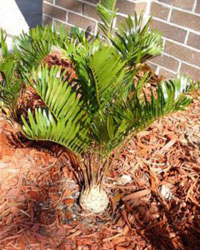Zamia floridana (syn. Z. integrifolia, Z. pumila) - Coontie



Family Zamiaceae
Description:
Over fifty species of Zamia are native to warm regions of North and South America. These plants may resemble ferns or small palms but they are a type of gymnosperm known as a cycad. Cycad fossils date back before the dinosaurs to about 300 million years ago. Modern cycads often live in difficult environments where the competition from other plants is low. Similar to pines, cycads produce cone-like structures called strobili. Seed-bearing and pollen-bearing strobili are borne on separate plants, a condition termed dioecious.
This plant, coontie, is native to much of Florida and is reported to range into Georgia. Although the plant contains some nasty toxins (neurotoxins and carcinogens,) its underground stems and roots were crushed, thoroughly washed and prepared as a starchy food by native Americans and early colonists. Despite this former use, anyone coming in contact with the sticky sap of this plant should wash it off quickly.
Coonties have interesting symbiotic relationships with other organisms. A tiny weevil pollinates the plants and uses the pollen-bearing strobili as food for its larvae. If the larvae try to eat the seed-bearing strobilis, they are poisoned. The weevil and the coontie is each dependent on the other for survival. In addition, nitrogen-fixing cyanobacteria live in root nodules of the coontie.
Coontie thrives in dry, upland areas where wildfires are common. The underground stem sends up new leaves quickly after a fire. Because these dry areas make good places to build our homes and businesses, coontie is listed as an endangered species in Florida.
Location:
See this plant in several locations including beds south of building 2.
Size:
Small shrub with an underground stem and leaves that grow to about eighteen to twenty-four inches tall.
Care Instructions:
Light: full sun to part shade
Water: very drought tolerant when established
Soil: well-drained, otherwise no special requirements
